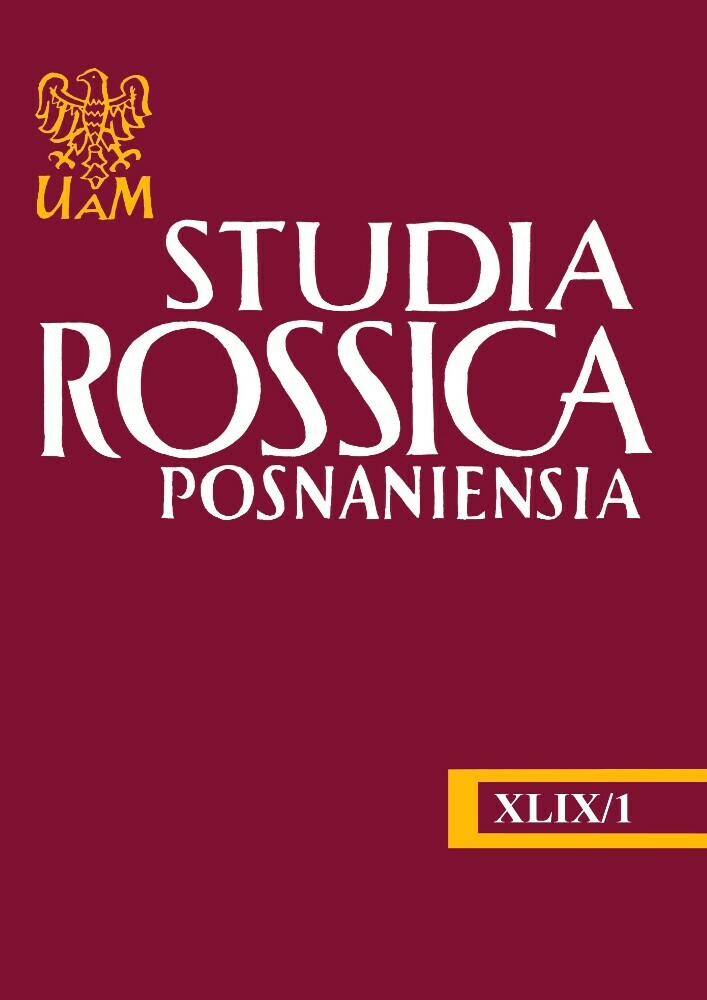Abstrakt
This article explores the significance of memorial plaques in Russian cities as sites of history, memory and aesthetics that create a new sensorium of the urban sphere. The plaques, affixed to historic buildings, serve as tangible markers that commemorate significant events and figures from the past. Taking the case of the historic center of St. Petersburg, the article examines how these plaques create a sense of historicity and contribute to the formation of a shared cultural background within the urban sphere. The plaques evolve from simple inscriptions to more elaborate and visually appealing designs. It also highlights the controversies surrounding the selection of individuals to be materialized and remembered and the aesthetic concerns raised by some residents. Meanwhile, the two contemporary projects challenge traditional commemorative practices and their aesthetics: Last Address, which commemorates victims of political repression through individualized plaques, and the Gandhi artist group’s street art interventions. These projects offer alternative approaches to memorialization and engage in dialogue with existing monuments and plaques. These micro-interventions show grassroot resistance within memorializing practices and aesthetics. The article emphasizes the contested nature of public space and the role of memorial plaques in shaping collective memory and historical narratives in Russian cities.
Bibliografia
Bakhtin, Mikhail M. The dialogic imagination: Four essays by M.M. Bakhtin. Ed. Michael Holquist, trans. by Caryl Emerson, Michael Holquist. Austin, University of Texas Press, 1981.
Batalina, Ûliâ. Sergej Parhomenko. “Žiznʹ v neznanii – èto žiznʹ nepolnocennaâ”. Web. 03.08.2023. https://www.newsko.ru/articles/nk-2204851.html.
Besedina, Elena, Tat’âna Burkova. “«V ètom zdanii žil i rabotal», memorialʹnye doski kak obraz istoričeskoj pamâti”. Trudy istoričeskogo fakulʹteta Sankt-Peterburgskogo universiteta, 25, 2013, pp. 45–67.
Buckler, Julie A. “The city’s memory: Texts of preservation and loss in imperial St. Petersburg”. Preserving Petersburg: History, memory, nostalgia. Eds. Helena Goscilo, Stephen M. Norris. Bloomington–Indianapolis, Indiana University Press, 2008.
Cresswell, Tim. In place/out of place: Geography, ideology, and transgression. Minneapolis, University of Minnesota Press, 1996.
Cresswell, Tim. “Night discourse: Producing/consuming meaning on the street”. Images of the street: Planning, identity and control in public space. Ed. Nicholas R. Fyfe. New York, Routledge, 2006, pp. 261–271.
Demnig, Gunter. “Am treffendsten läßt sich meine Berufsbezeichnung mit Bildhauer umschreiben, Uta Franke im Interview mit Gunter Demnig”. Stolpersteine für die von den Nazis ermordeten ehemaligen Nachbarn aus Friedrichshain und Kreuzberg: Dokumentation, Texte und Materialien zu einer im öffentlichen Raum. Ed. Bettina Eisbrenner. Berlin, Vice-Versa-Verlag, 2002, pp. 9–24.
Dima. „Re: Novye pamâtniki i dekorativnaâ skulʹptura v Sankt-Peterburge v 2012 godu”. Beguŝij gorod. Web. 12.05.2023. https://www.runcity.org/forum/index.php?topic=24800.msg265466#msg265466.
Dziewanska, Marta, Ekaterina Degot, Ilya Budraitskis, eds. Post-Soviet? Art, politics & society in Russian at the turn of the decade. Book no. 7, Warsaw, Museum of Modern Art, 2013.
Gould, Mary R., Rachel E. Silverman. “Stumbling upon History: Collective Memory and the Urban Landscape”. GeoJournal, 67, 2013, pp. 791–801. DOI: https://doi.org/10.1007/s10708-012-9466-6
Griswold, Charles L. “The Vietnam Veterans Memorial and the Washington mall: Philosophical thoughts on political iconography”. Art and the public sphere. Ed. W.J.T. Mitchell. Chicago, The University of Chicago Press, 1992, pp. 79–112.
Harjas, Kirsten. “Stumbling stones. Holocaust memorials, national identity and democratic inclusion in Berlin”. German Politics and Society, 23, 2005, pp. 138–151. DOI: https://doi.org/10.3167/104503005780889237
Irvine, Martin. “The work on the street: street art and visual culture”. The handbook of visual culture. Eds. Barry Sandywell, Ian Heywood. London, Bloomsbury Publishing, 2012, pp. 235–278. DOI: https://doi.org/10.5040/9781474294140.ch-010
Jonson, Lena. „Dissent in art”. Lena Jonson. Art and protest in Putin’s Russia. New York, Routledge, 2015, pp. 130–164. DOI: https://doi.org/10.4324/9781315728469
MacFarquhar, Neil. “Critics scoff as Kremlin erects monument to the repressed”. The New York Times. Web. 12.05.2023. www.nytimes.com/2017/10/30/world/europe/russia-soviet-repression-monument.html.
„Medinskij nazval Mannergejma «geroem» i požalovalsâ na «marginalov»”. Regnum.ru. Web. 18.04.2024. https://docs.cntd.ru/document/8405108.
Memorial. Web. 12.05.2023. project.memo.ru/.
Nočležki. Vot bolee polnyj perepost Nočležki. Web. 12.05.2023. www.facebook.com/Homeless.ru/photos/pcb.1215190975162762/1215190388496154/?type=3&theater.
Nora, Pierre. “General introduction: Between memory and history”. Realms of memory: Conflicts and divisions. Eds. Pierre Nora, Lawrence D. Kritzman, trans. by Arthur Goldhammer. New York, Columbia University Press, 1996, pp. 1–21.
Obŝestvo Memorial. Upravlâûŝaâ kompaniâ v Sankt-Peterburge otkazala donosčiku v demontaže tabliček Poslednego adresa. Web. 13.12.2023. https://t.me/toposmemoru/5227.
Obŝestvo Memorial. V Peterburge iz-za donosov prodolžaût snimatʹ tablički Poslednego adresa – a mestnye žiteli prodolža. Web. 13.12.2023. https://t.me/toposmemoru/5290.
Östman, Lars. The Stolpersteine and commemoration of life, death, and government. Frankfurt, Peter Lang, 2018. DOI: https://doi.org/10.3726/b12483
Ponosov, Igor. “Rebirth of Russian street art during the protest movement”. Nuart Journal. Web. 12.05.2023. nuartjournal.com/igor-ponosov/.
“Poslednij adres”: komu nužna pamâtʹ o neizvestnyh žertvah repressij?. Web. 03.08.2023. https://www.poslednyadres.ru/articles/echo_komu_nuzhna_pamyat.htm.
Postanovlenie Pravitelʹstva Sankt-Peterburga ot 17.01.2005 No. 2 “O Memorial’nykh doskakh v Sankt-Peterburge”. Web. 12.05.2023. https://docs.cntd.ru/document/8405108.
Sergej Parhomenko: “Poslednij adres”. Vremâ sobiratʹ kamni. Web. 03.08.2023. http://pmem. ru/2953.html.
Vološina, Viktoriâ. “Ubivalo lûdej gosudarstvo, i pamâtnik dolžno stavitʹ gosudarstvo”. Gazeta.ru. Web. 12.05.2023. www.gazeta.ru/comments/2017/10/26_a_10958624.shtml?updated.
Volʹtskaâ, Tatʹâna. “V Peterburge poâvilasʹ «alʹternativnaâ doska» Kolčaku”. Radio Svoboda. Web. 12.05.2023. www.svoboda.org/a/28069365.html.
Volʹtskaâ, Tatʹâna. “V Sankt-Peterburge osporili demontaž memorialʹnoj doski Kolčaku”. Radio Svoboda. Web. 12.05.2023. www.svoboda.org/a/28646653.html.
Young, James E. “The counter-monument: Memory against itself in Germany today”. Art and the public sphere. Ed. W.J.T. Mitchell. Chicago, The University of Chicago Press, 1992, pp. 49–78.
Licencja
Prawa autorskie (c) 2024 Kiun Hwang

Utwór dostępny jest na licencji Creative Commons Uznanie autorstwa – Użycie niekomercyjne – Na tych samych warunkach 4.0 Międzynarodowe.

